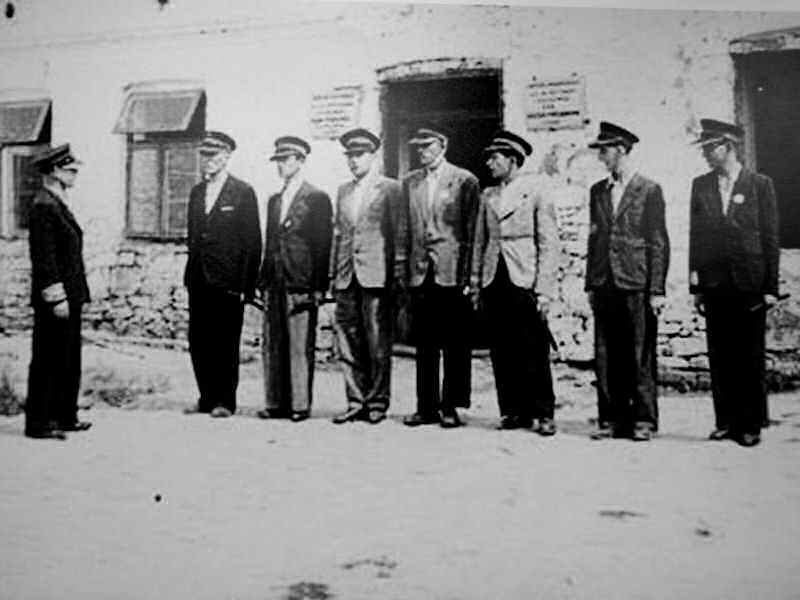Szydłowiec, a town in the southern part of the Mazovian Voivodeship, has over the centuries become a place dominated by the Jewish population. The actions of the Germans during World War II led to the almost complete destruction of that community. On 23 September 1942, the Nazis commenced the liquidation of the Szydłowiec ghetto.
The first Jews appeared in Szydłowiec in the second half of the 16th century, but probably only at the end of the 17th century the Jewish population soared. At the beginning of the 18th century, a Jewish kehilla was established in Szydłowiec and the number of Jews reached about 300 and was increasing all the time. They settled in a separate part of the town called “Jewish Town”. In addition to houses, they constructed religious buildings, such as a synagogue for the employees of the local tanning factory. The town developed economically, with the mining of sandstone and the flourishing of several crafts, which influenced the settlement of foreign professionals. During this period, the town’s owners, representatives of the Radziwill family, ensured peaceful coexistence between Catholic, Protestant and Jewish residents. Nonetheless, there were disputes over finances and due to Jews breaking the ban on settling in the Catholic part of the town.
In the second half of the 19th century, the Jewish population already accounted for more than half of the town’s population (in 1862, more than 70% of 4,022 people). By the beginning of the First World War, the Jewish had financed many public buildings for its community. The money for those investments came from compulsory contributions from people subject to the kehilla. During the partitions, part of the Jewish community belonged to political parties. Among others, the PPS and the Jewish Bund were active in the town. At the beginning of the interwar period, the proportion of the Jewish population in the city’s population reached a record figure 76.1%. This was never repeated, despite a steady increase in the Jewish population, due to the incorporation of the surrounding villages, whose inhabitants were mostly Poles, into the town. Jewish parties and numerous social organisations were active in the town. Jews also held most seats in the city council, although this ended in scandal during one term due to allegations of cronyism.
The Nazi aggression began when there were around 7,000 Jews in the town (some sources say there may have been as many as 7,600). Fear of the Nazis, as well as of conscription, caused several hundred citizens of the town to flee. The Germans occupied Szydłowiec at the turn of 8 and 9 September 1939. Immediately after the invasion, the Nazis forced the Jewish population into humiliating work, such as sweeping the streets in religious dress. Jewish religious buildings were vandalised, and heavy contributions were imposed on members of the Jewish community, the failure to pay them in full could result in the murder of Jewish officials. Five hundred representatives of the Jewish youth of Szydłowiec were forced into gruelling labour to build drainage canals. Instead of the traditional form of municipality, a Judenrat was set up to issue passes, provide welfare, issue food and pass on the occupier’s orders to the population. A ghetto was established which, although it covered almost the entire city, was a so-called open ghetto. This gave the residents a limited opportunity to travel during the day. This allowed the inhabitants to travel outside the city for food.
However, in 1942, the situation deteriorated significantly. As a result of the Germans’ liquidation of ghettos in the surrounding towns, the Jewish population in Szydłowiec reached about 16,000 people and the ghetto area was reduced to two districts, at the same time limiting the possibility of movement. The squeezing of many people into a relatively small area resulted in the mass spread of diseases such as typhus and dysentery. Despite the reduction of space in the ghetto, it was still not fenced, and the only guards were Gestapo posts set up at the corners. This provided opportunities to sneak out in search of food. This was, for example, the case of Maria Wajsbrot, who during one of the September nights left the area designated by the Gestapo. Next day the liquidation of the ghetto began, so Wajsbrot was unable to return to her family. She managed to survive thanks to the help of the Polish Madejski family, who hid her. Subsequently, Adam Madejski, who worked at the municipal office, produced false documents for her.
The Germans began the liquidation of the ghetto on 23 September 1942. They surrounded the area where thousands of Jews were squeezed together, and formed marching columns from its inhabitants to the railway station. Those unable to march were killed on the spot. The ghetto’s inhabitants were sent to the Treblinka extermination camp (there were two transports due to the large number of people). Some Jews tried to hide in the ghetto, also with the help of Polish residents, but these attempts were unsuccessful. Escape was also attempted during the deportation, but only a few managed to run far enough to avoid being reached by German bullets.
However, this is not where the history of the Szydlowiec ghetto ends. On 10 November 1942 it was announced that one of the “secondary ghettos” would be established in Szydłowiec. It was to be a closed and guarded area, but according to the assurances of the occupier, those who were to report to it were promised safety. Jews who had managed to survive the German pogroms began arriving in the ghetto. It turned out, however, that this was a trap for survivors hiding in the forests or Polish farms. The Jews gathered by this ruse were murdered by the Germans or deported to labour camps. This was the last act of the tragedy of the Szydlowiec Jewish community.





